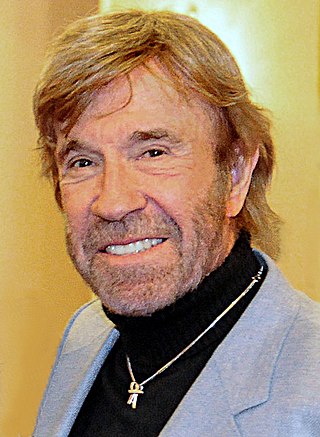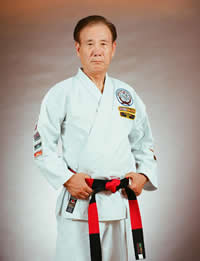
Taekwondo, also spelled tae kwon do or taekwon-do, is a Korean martial art involving punching and kicking techniques. The literal translation for taekwondo is "kicking", "punching", and "the art or way of". It sometimes involves the use of weapons.

Carlos Ray "Chuck" Norris is an American martial artist and actor. He is a black belt in Tang Soo Do, Brazilian jiu jitsu and judo. After serving in the United States Air Force, Norris won many martial arts championships and later founded his own discipline, Chun Kuk Do. Shortly after, in Hollywood, Norris trained celebrities in martial arts. Norris went on to appear in a minor role in the spy film The Wrecking Crew (1969). Friend and fellow martial artist Bruce Lee invited him to play one of the main villains in The Way of the Dragon (1972). While Norris continued acting, friend and student Steve McQueen suggested he take it seriously. Norris took the starring role in the action film Breaker! Breaker! (1977), which turned a profit. His second lead, Good Guys Wear Black (1978), became a hit, and he soon became a popular action film star.

Shotokan is a style of karate, developed from various martial arts by Gichin Funakoshi (1868–1957) and his son Gigo (Yoshitaka) Funakoshi (1906–1945). Gichin Funakoshi was born in Okinawa and is widely credited with popularizing "karate do" through a series of public demonstrations, and by promoting the development of university karate clubs, including those at Keio, Waseda, Hitotsubashi (Shodai), Takushoku, Chuo, Gakushuin, and Hosei.

Jae-chul Shin was a Korean martial artist and founder of the World Tang Soo Do Association.
Gojūshiho is a kata practiced in karate. Gojushiho was developed by Sokon Matsumura, one of the key founders of Okinawan martial arts and named it "Uesheishi", which literally means 54 methods in Chinese. In some styles of karate, there are two versions of this kata - Gojūshiho Shō and Gojūshiho Dai. An advantage of the two versions of the kata is to better master the difficult techniques presented therein, but not without facing some confusion, for many sequences are the same and others only slightly different. The embusen of both Gojūshiho Shō and Gojūshiho Dai are nearly identical. Gojūshiho Shō begins straight off with a wide variety of advanced techniques and, as such, is highly recommended for study. Gojūshiho Dai consists of many advanced open-handed techniques and attacks to the collar-bone.
The United Fighting Arts Federation (UFAF) is a martial arts organization founded by Chuck Norris in 1979. UFAF is the governing and sanctioning body for the Chuck Norris System, a martial art Norris developed from Tang Soo Do, and which was known as the Chuck Norris System in the early to mid 1980s and as Chun Kuk Do from December 1990 until July 2015. UFAF provides technical standards for instruction and advancement in the system, and also provides its students, instructors, and schools with Chuck Norris System rank certification, educational opportunities, special events, online community access, and other services.
Hwa Rang Do, also known as "The Way of the Flowering Knights", is a comprehensive Korean martial art that was developed in the 1960s by Joo Bang Lee and his brother Joo Sang Lee. It has multiple areas of focus, including stand-up fighting with open-hand striking, weapons, throws and takedowns; ground fighting; various types of meditative practices; intellectual and character development; and artistic and cultural pursuits.

Tang Soo Do is a Korean martial art based on karate and may include fighting principles from taekkyeon, subak, as well as northern Chinese martial arts. From its beginnings in 1944 to today, Tang Soo Do is used by some Kwans to identify the traditional Korean fusion of martial arts styles. In the mid 1950s, Tang Soo Do became the basis for the martial art Taekwondo when the Korean Nine Kwans united.
The Pinan (平安)kata are a series of five empty hand forms taught in many karate styles. The Pinan kata originated in Okinawa and were adapted by Anko Itosu from older kata such as Kusanku and Channan into forms suitable for teaching karate to young students. Pinan is the Chinese Pinyin notation of 平安; when Gichin Funakoshi brought karate to Japan, he spelt the kata name as Heian, which is the onyomi of 平安. Pinan or Heian means "peaceful and safe". Korean Tang Soo Do, one of 5 original kwan of Korea, also practice these kata; they are termed, "Pyong-an" or "Pyung-Ahn", which is a Korean pronunciation of the term "ping-an".
Hwang Kee was one of the most important and influential figures in the Korean martial arts. He was the founder of the school of Tang Soo Do Moo Duk Kwan style.
The Korean terms hyeong, pumsae, poomsae and teul are all used to refer to martial arts forms that are typically used in Korean martial arts such as Taekwondo and Tang Soo Do.
Soo Bahk Do (수박도) is a martial art founded and taught by Kwan Jang Nim Hwang Kee, his successor Hwang Hyun Chul, known as H.C. Hwang, and instructors who are certified by member organizations of the World Moo Duk Kwan, Inc. This martial art was originally the ancient martial art of Korea. Hwang Kee created Moo Duk Kwan with influence from "Soo Bahk Do."
Chung Do Kwan, created by Won Kuk Lee in 1944, is one of the first of nine schools or kwan teaching Tang Soo Do. Later, the school began to teach what came to be known as taekwondo. This style of Tang Soo Do is known for its overall power and emphasis on kicks to the head.

Patrick E. Johnson was an American martial artist. He was a 9th degree black belt in American Tang Soo Do and was the president of the National Tang Soo Do Congress, which was originally created by Chuck Norris in 1973.
Kim Pyung-soo, also known as Kim Soo, is a South Korean taekwondo practitioner.
Hwang Hyun-chul is a South Korean martial artist who is a ninth-degree midnight blue belt in Soo Bahk Do Moo Duk Kwan and the son of the late Hwang Kee, founder of the Soo Bahk Do Moo Duk Kwan system.
Lee Won-kuk was a South Korean martial artist, who founded Chung Do Kwan. He introduced karate to Korea in 1944, creating his own style known as Tang Soo Do Chung Do Kwan style, which became Taekwondo as of 1955; instilling a profound influence in this martial art through teaching future masters and authoring the book “Tae Kwon Do handbook“ in 1968.

Sun-hwan Chung, also known as James Sun-hwan Chung, is one of the highest-ranking Tang Soo Do, Hapkido, and taekwondo grandmasters in the world. He is founder of the Moo Sool Do form of martial arts and is president of the World Academy of Martial Arts, LLC.
Robert Allen Cheezic was an American martial artist specializing in the art of Tang Soo Do. He was a major mover of Tang Soo Do in the Northeastern United States and was the founder of the Cheezic Tang Soo Do Federation, one of the oldest American martial arts organizations focusing on Tang Soo Do.

The World Tang Soo Do Association is an international Tang Soo Do association headquartered in Burlington, North Carolina. As of 1996, the organization claimed to have over 160,000 members.







